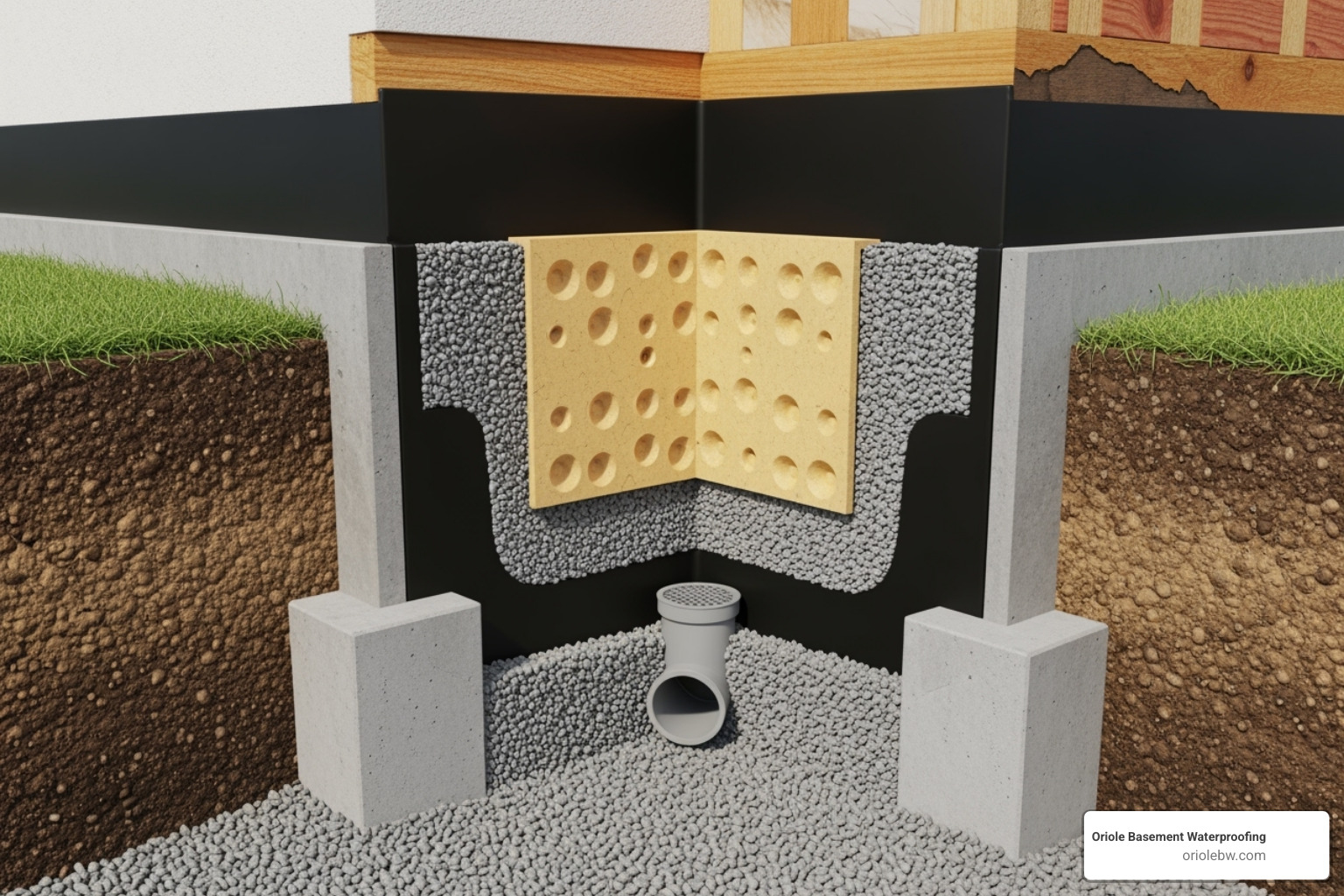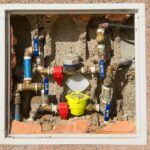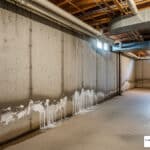Why Fixing Basement Leaks from the Outside Is Your Best Defense
When you fix basement leak from outside, you stop the problem at its source, before water ever reaches your basement walls. Here’s what you need to know:
Quick Solutions to Fix Basement Leaks from Outside:
- Excavate and waterproof foundation walls with membrane systems
- Install exterior French drains to redirect groundwater away
- Repair foundation cracks at the source with professional-grade materials
- Improve grading so water flows away from your foundation
- Maintain gutters and downspouts to prevent water pooling
- Secure window wells with proper drainage and covers
Living in Maryland or Pennsylvania, you know our weather is unpredictable. That puddle in your basement isn’t just a puddle; it’s a sign of a bigger problem happening outside your foundation walls.
Most homeowners don’t realize that water in the basement starts its journey outside. It could be poor grading, foundation cracks, or clogged gutters dumping water right where you don’t want it.
The good news is that addressing these exterior issues prevents future flooding. After 70+ years of keeping local basements dry, we know the most effective waterproofing happens before water ever touches your foundation.

Why Is Water Getting In? Uncovering the Root Causes of Exterior Leaks
After 70 years of inspecting Maryland and Pennsylvania basements, we’ve become detectives when it comes to water leaks. Every puddle tells a story that usually starts outside your foundation walls.
Think of your basement like a boat hull. The smallest weak spot can let water in, especially under pressure. This is called hydrostatic pressure. When heavy rains saturate the soil around your foundation, it expands and forces water through any opening it can find, even microscopic pores in the concrete.
Much of Maryland and Pennsylvania has heavy clay soil, which acts like a sponge. It swells when wet and shrinks when dry, putting constant stress on your foundation. This leads to foundation settlement and foundation cracks that create a direct path for water.
Other common culprits include poor grading that funnels rain toward your house, clogged gutters that overflow, short downspouts that dump water at the foundation, and leaky window wells that collect water with nowhere to go.
When our experts visit, we don’t just look for the wet spot. We investigate the whole story: the soil, grading, foundation condition, and water flow. This engineering-backed approach helps us find the true cause of the leak, because simple landscaping changes can reduce moisture problems when you know where to look.
Understanding Foundation Cracks and Wall Integrity
Foundation cracks aren’t just cosmetic; they tell a story about your foundation’s health. We’ve seen them all across Maryland and Pennsylvania.
- Vertical cracks usually indicate foundation settlement. They can start small but grow into serious water entry points.
- Horizontal cracks are a cry for help, signaling serious hydrostatic pressure. A wall with horizontal cracks is under stress and may be bowing inward.
- Stair-step cracks in block walls usually mean one part of the foundation is moving differently than another.
The most alarming issue is bowing walls, where a wall buckles inward from pressure. We often reinforce these walls with carbon fiber straps, which are incredibly strong and provide structural support.
Patching cracks from the inside is like putting a band-aid on a broken bone. It doesn’t fix the cause. The outside pressure remains, and the patch will likely fail. When you fix basement leak from outside, you address both the crack and the pressure causing it.
The Impact of Grading and Surface Water
The slope of your yard is a critical factor in keeping your basement dry. A positive slope angles away from your foundation, directing rainwater safely away. A negative slope is the troublemaker, directing water toward your house and creating water pooling near foundation walls. This saturates the soil and puts constant pressure on your foundation.
Even well-intentioned landscaping can cause problems. Garden beds against the house, new patios, or poorly placed trees can alter drainage and lead to saturated soil. Understanding how landscaping choices affect drainage is key. Our holistic approach assesses your entire property’s water management to find the right solution.

The Professional Process to Fix a Basement Leak from Outside
We tell every homeowner that fixing a basement leak from the outside isn’t a DIY weekend project. While we admire the can-do spirit, our 70+ years of experience in Maryland and Pennsylvania have shown us the risks of going it alone.
This work requires heavy equipment, professional-grade materials, and a deep understanding of local soil. A mistake can damage utility lines, compromise your foundation, or worsen drainage problems. Professional expertise is crucial because your foundation holds up your entire house. When we fix basement leak from outside, we’re preserving its structural integrity. Our certified team has decades of experience with our region’s clay soils, freeze-thaw cycles, and older homes.
Let’s walk through our process for a permanent solution.
Step 1: A Full Foundation and Drainage Assessment

Before we break ground, our experienced technicians conduct a thorough inspection. This structural integrity check is more than just finding the leak. We look for settlement, cracks, and bowing walls, as a simple leak can point to bigger structural issues.
Identifying the true source of the leak is key. Our engineering-backed solutions mean we partner with structural engineers for major repairs to ensure we plan the repair with precision, addressing the root cause. Safety is always first, which is why we always contact 811 before you dig to mark utility lines.
Step 2: Excavation and Foundation Wall Preparation
With a clear plan, the work begins. Safe excavation practices are critical. We carefully expose your foundation while protecting your landscaping, utilities, and home’s structure. Exposing the foundation down to the footing means digging several feet deep, which in our area often involves working in tight spaces and with heavy clay soil.
After excavation, we thoroughly clean the wall surface, removing old materials and loose concrete. This is crucial for the waterproofing to create a perfect seal. We then repair cracks and defects at the source, which might involve injecting specialized materials or installing carbon fiber straps to reinforce bowing walls.
Step 3: How to Fix a Basement Leak from Outside with a Multi-Layered System

To fix basement leak from outside, we install a comprehensive system designed for permanent protection.
First is applying a seamless waterproof membrane. This high-performance material creates a continuous, impenetrable barrier from the footing up to grade level.
Next, we install a protective dimple board. This protects the membrane and creates an air gap, allowing water to flow downward instead of pressing against the wall.
The final piece is installing an exterior French drain (or weeping tile). This perforated pipe sits in a bed of gravel at the base of your foundation, collecting water and connecting to a drainage system that carries it safely away from your home.
This multi-layered approach manages water, controls it, and directs it away from your foundation permanently.
Beyond the Trench: Other Key Exterior Solutions
When you fix basement leak from outside, the work doesn’t stop at the foundation wall. A complete solution is like a symphony; every part must work together for a dry basement. Our 70+ years of experience have taught us that gutters, downspouts, and window wells are key players. If one part fails, water problems can return.
The Critical Role of Gutters and Downspouts
Your gutters and downspouts are the unsung heroes of waterproofing. When working properly, they channel thousands of gallons of rainwater safely away from your foundation.
But clogged gutters are a major villain. When they overflow, they dump water directly against your foundation. If your downspouts are too short, they create a pool of water right at your foundation’s base.
The importance of extensions is huge. We recommend directing water at least 6 to 10 feet away. Directing water far from the foundation is a key investment in a dry basement.
How to Fix a Basement Leak from Outside by Securing Window Wells
Basement window wells bring in light, but they can also collect water if not managed properly. We often see common window well leak points where pooled water seeps through the frame, the foundation, or overflows during heavy rain.
A window well drain is essential. It connects to your exterior drainage system, preventing the well from filling with water. A secure window well cover also keeps out leaves and debris that can clog drains and cause water to back up. When we fix basement leak from outside by securing your window wells, we’re creating a comprehensive barrier that protects your home.

Exterior vs. Interior Waterproofing: Which is Right for You?
When homeowners in Maryland and Pennsylvania ask us about keeping their basements dry, they’re usually surprised to learn there are two distinct approaches. Think of it this way: exterior waterproofing is like putting on a raincoat before you go outside, while interior waterproofing is like having a good umbrella once you’re already getting wet.
After 70+ years of working in basements across our region, we’ve learned that understanding the two main approaches to a dry basement helps homeowners make informed decisions. Why might one be recommended over the other for your specific home? It comes down to your foundation’s condition, the severity of your water issues, and what makes the most sense for your situation.
Exterior waterproofing tackles the problem exactly where we’ve been discussing – from the outside. We excavate around your foundation, apply waterproof membranes, install drainage systems, and ensure water never reaches your basement walls. It’s the most comprehensive way to fix basement leak from outside because it addresses the root cause. Think of it as building a fortress around your foundation.
Interior waterproofing, on the other hand, works with the reality that some water might still find its way to your foundation walls. Instead of trying to keep every drop out, we install an interior drainage system around the perimeter of your basement floor. This system captures any water that does seep through and directs it to a sump pump, which then pumps it safely away from your home.
Here’s how they compare side by side:
| Factor | Exterior Waterproofing | Interior Waterproofing |
|---|---|---|
| Method | Excavation, membrane application, exterior drain tile, grading improvements | Interior drainage system, sump pump installation, crack injections, vapor barriers |
| Best For | Severe hydrostatic pressure, foundation structural issues, stopping water at its source, protecting finished basements | Managing existing water entry, situations where excavation isn’t practical, more budget-friendly solutions |
| Cost | Higher upfront investment due to excavation and materials | Generally more affordable initially, though ongoing maintenance costs should be considered |
| Longevity | Designed as a permanent solution with our lifetime transferable guarantee | Highly effective with proper maintenance, especially of sump pump components |
Sometimes, the best approach is actually a hybrid approach that combines both methods. We might recommend addressing major exterior drainage issues while also installing a robust interior sump pump system for extra protection. It’s like wearing both a raincoat and carrying an umbrella – double protection for those unpredictable Maryland and Pennsylvania storms.
The role of an interior sump pump becomes critical in many waterproofing systems, acting as the heart that keeps everything flowing smoothly. That’s why we specialize in reliable sump pump battery backups in Howard County, MD and sump pump battery backups in York County, PA. Because when the power goes out during a storm, which always seems to happen at the worst possible moment, your basement protection shouldn’t skip a beat.
The decision between exterior and interior solutions isn’t always black and white. Our engineering-backed assessments help determine what makes the most sense for your specific situation, your budget, and your long-term goals for your home.
Frequently Asked Questions about Exterior Waterproofing
With over 70 years of experience helping homeowners fix basement leak from outside, we’ve heard every question. Here are the most common ones:
How much does exterior basement waterproofing cost?
This is always the first question, and we get it. It’s a significant investment in your home. The average cost per linear foot is typically $100 to $300, but every home is different. Several factors affect the price.
Foundation depth is a major factor, as is the local soil condition. The heavy clay soil in our area can be difficult to excavate. The extent of repairs needed, like fixing cracks or other structural issues, also impacts the final cost.
We see this as an investment in your home’s value. A dry, sound basement protects your entire house and prevents the recurring costs of water damage, mold, and structural problems that come from not fixing the root cause.
How long does the process take?
Most projects take 3 to 7 days, depending on the size and complexity. This covers everything from excavation to final cleanup. The typical project timeline includes excavation, wall prep, repairs, installing the waterproofing system, backfilling, and restoring your landscaping.
Weather can impact the schedule, but we never compromise on quality or safety. We’ll keep you informed and work to get the job done as quickly as possible.
Is exterior waterproofing a permanent solution?
Yes, when done right, it is permanent. The importance of professional installation is critical. Our certified technicians know how to build an integrated system that lasts. We use high-quality materials designed for our local climate, built to last for decades.
Most importantly, we back our work with our lifetime transferable guarantee. This adds value to your property and gives you peace of mind that when we fix basement leak from outside, it stays fixed.
A Dry Basement Starts with a Healthy Foundation
After 70+ years of serving Maryland and Pennsylvania, we know that fixing basement leaks from outside is about more than stopping water; it’s about preserving your home’s structural integrity.
Addressing the problem at its source prevents future foundation settlement, mold, and costly damage. An exterior system is an investment in your home’s value and your peace of mind.
What sets Oriole Basement Waterproofing apart is our commitment to our Maryland and Pennsylvania neighbors. We understand the local soil, weather, and the unique challenges of homes in our area, from Baltimore rowhomes to newer construction.
Our engineering-backed solutions are designed to last. When we fix basement leak from outside with our multi-layered system, French drains, and foundation repairs, we back that work with a lifetime transferable guarantee. That’s our promise that your basement will stay dry for decades.
Whether you’re dealing with foundation cracks that need carbon fiber reinforcement, hydrostatic pressure that requires exterior excavation, or grading issues, we’ve seen it all and solved it all. We’re not just fixing leaks; we’re building lasting relationships with homeowners who can finally use their basements without worry.
For a permanent solution to your wet basement, learn more about our expert waterproofing and sump pump battery backup services in Baltimore, MD. Your dry basement starts with one phone call.






